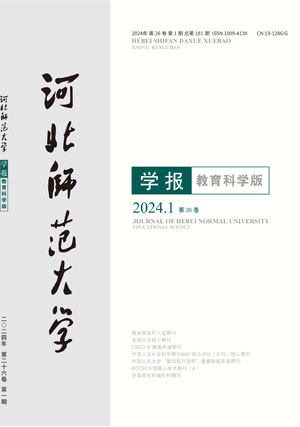期刊信息

- 刊名: 河北师范大学学报(教育科学版)Journal of Hebei Normal University (Educational Science Edition)
- 主办: 河北师范大学
- ISSN: 1009-413X
- CN: 13-1286/G
- 教育部名栏入选期刊
- 全国中文核心期刊
- CSSCI扩展版来源期刊
- AMI综合评价(A刊)核心期刊
- RCCSE中国核心学术期刊
- 全国高校特色栏目社科学报
- 中国人民大学“复印报刊资料”重要转载来源期刊
- 全国高校权威社科期刊
中国最早的思政课程:溯源与镜鉴
-
作者单位:(1.南京晓庄学院 教师教育学院;2.南京师范大学 道德教育研究所,江苏 南京 211171) -
起止页码:39 - 47页 -
DOI:10.13763/j.cnki.jhebnu.ese.2024.01.005
The Earliest Ideological and Political Course in China: Origin and Contemporary Significance
摘要/Abstract
新时代思政课的守正创新可从中华优秀传统文化中寻求源头活水。追本溯源,中国最早的课程肇始于六艺——礼、乐、射、御、书、数,最早的思政课程亦滥觞于此。作为六艺之首,礼集政治、思想、道德与礼仪之教为一体,在德、行课程缺位的背景下,承担了学校“育德”之教的使命,是中国最早的思政课程,或称之为“育德课程”。崇礼明伦是礼的课程目标,五礼六仪是礼的课程内容,二者共同构成了礼的课程核心要素,承担着学校思政课程的育人使命。六艺之中,除了作为思政课程的礼之外,其它五艺也不同程度地肩负着课程“育德”之责,蕴含了中国最早的课程思政理念,从大中小学思政课一体化以及思政课程与课程思政的同向同行两个维度,为新时代思政课的守正创新提供了历史镜鉴。
In traditional Chinese culture, we could find the origin and inspiration for the integrity and innovation of the ideological and political courses in the new era. Tracing back to the roots, the earliest curriculum in China originated from the Six Arts—rites, music, archery, charioteering, calligraphy, and mathematics, so did the earliest ideological and political course. As the most fundamental one of the Six Arts, “rites” integrate politics, ideology, morality, and etiquette. In the absence of courses on virtue and conduct, “rites” undertook the mission of “moral education,” constituting the earliest ideological and political course in China, also known as the “moral education curriculum.” Valuing etiquette and ethics was the objective of the course of “rites”, while the “five rites and six rituals” were the teaching content of it. Together, they formed the core elements of “rites,” undertaking the mission of educating students with ideological and political courses at schools. Among the Six Arts, apart from “rites” as the ideological and political course, the other five arts, to various degrees, also bore the responsibility of “moral education,” embodying the initial Chinese concept of the integration of ideological and political elements in the teaching of professional courses. They provide historical reference for the integrity and innovation of the ideological and political courses in the new era from two dimensions, namely, the integration of ideological and political courses in primary and secondary schools and universities, and the coordinated development of the ideological and political courses and the integration of ideological and political elements in the teaching of professional courses.
关键词
参考文献 40
- [ 1 ] 习近平.高举中国特色社会主义伟大旗帜为全面建设社会主义现代化国家而团结奋斗——在中国共产党第二十次全国代表大会上的报告[N].人民日报,2022-10-26.
- [ 2 ] 陈融融.传统文化与思想政治教育[J].高教发展与评估,2009,25(5):112-115+124.
- [ 3 ] 陈万柏,张耀灿.思想政治教育学原理[M].北京:高等教育出版社,2007.
- [ 4 ] 王弼注,孔颖达疏,阮元校刻.周易正义[A].十三经注疏(清嘉庆刊本)[C].北京:中华书局,2009.
- [ 5 ] 檀传宝.德育与班级管理[M].北京:高等教育出版社,2013.
- [ 6 ] 习近平.思政课是落实立德树人根本任务的关键课程[J].求是,2020(17):4-16.
- [ 7 ] 武东生,徐昊,余一凡.中国古代思想政治教育史[M].天津:南开大学出版社,2013.
- [ 8 ] 孙培青.中国教育简史[M].北京:中国人民大学出版社,2021.
- [ 9 ] 薛桂琴.高校课程思政的实践哲学意蕴[J].高校教育管理,2021(6):25-32.
- [ 10 ] 杨向东.六艺中的乐、射、御与体育、美育[J].南开学报,2002(6):98-102.
- [ 11 ] 孙培青.中国教育史(第四版)[M].上海:华东师范大学出版社,2019.
- [ 12 ] 郭强.“六艺”蕴含的育人智慧[N].中国教育报(理论周刊),2023-03-30.
- [ 13 ] 郑玄笺,孔颖达疏,阮元校刻.毛诗正义[A].十三经注疏(清嘉庆刊本)[C].北京:中华书局,2009.
- [ 14 ] 章小谦,杜成宪.中国课程概念从传统到近代的演变[J].华东师范大学学报(教育科学版),2005(4):65-74.
- [ 15 ] 董金裕.《周礼》六艺的内涵及其在教育上的作用[J].孔子研究,2014(1):10-15.
- [ 16 ] 郑玄注,贾公彦疏,阮元校刻.周礼注疏[A].十三经注疏(清嘉庆刊本)[C].北京:中华书局,2009.
- [ 17 ] 吕达.课程史论[M].北京:人民教育出版社,1999.
- [ 18 ] 郑玄注,孔颖达疏,阮元校刻.礼记正义[A].十三经注疏(清嘉庆刊本)[C].北京:中华书局,2009.
- [ 19 ] 邱伟光.思想政治教育学概论[M].天津:天津人民出版社,1988.
- [ 20 ] 中共中央马克思恩格斯列宁斯大林著作编译局.马克思恩格斯选集(第一卷)[M].北京:人民出版社,1995.
- [ 21 ] 张瑞璠.中国教育史研究(先秦分卷).上海:华东师范大学出版社,2009.
- [ 22 ] 梅汝莉,谭佛佑,施克灿.中国教育通史:先秦卷(上)[M].北京:北京师范大学出版社,2013.
- [ 23 ] 吴龙辉.六艺的变迁及其与六经之关系[J].中国哲学史,2005(2):42-47.
- [ 24 ] 丛文俊.《周礼》“三德”、“道艺”古义斠诠[J].史学集刊,1998(2):58-61.
- [ 25 ] [美]拉尔夫·泰勒著.课程与教学的基本原理[M].施良方,译.北京:人民教育出版社,1994.
- [ 26 ] 马宝娟.大中小学思政课协同育人的内在理据与体系构建[J].教育科学,2021,37(1):54-60.
- [ 27 ] 毛礼锐.中国古代教育史[M].北京:人民教育出版社,1983.
- [ 28 ] 杨伯峻.春秋左传注(上)[M].北京:中华书局,2018.
- [ 29 ] 樊树志.国史概要[M].上海:复旦大学出版社,2010.
- [ 30 ] 杨伯峻.孟子译注[M].北京:中华书局,2008.
- [ 31 ] 张怀通.商周礼容考论[J].古代文明,2016,10(2):24-35+112.
- [ 32 ] 中国政府网.教育部关于进一步加强新时代中小学思政课建设的意见[EB/OL](2022-11-04)[2023-11-21].https://www.gov.cn/zhengce/zhengceku/2022-11/11/content_5726114.htm.
- [ 33 ] 孔广森.大戴礼记补注[M].北京:中华书局,2013.
- [ 34 ] 中国政府网.中共中央办公厅国务院办公厅印发《关于深化新时代学校思想政治理论课改革创新的若干意见》[EB/OL](2019-08-14)[2023-11-22].https://www.gov.cn/zhengce/2019-08/14/content_5421252.htm.
- [ 35 ] 李寒梅.大中小学思政课一体化建设的课程逻辑与实践理路[J].课程.教材.教法,2021(3):55-61.
- [ 36 ] 郑崇玲.新中国成立以来党领导高校思政课建设的历史考察[J].中国高校社会科学,2020(3):19-28+157.
- [ 37 ] 高德毅,宗爱东.课程思政:有效发挥课堂育人主渠道作用的必然选择[J].思想理论教育导刊,2017(1):31-34.
- [ 38 ] 石书臣.正确把握“课程思政”与思政课程的关系[J].思想理论教育,2018(11):57-61.
- [ 39 ] 刘瑞.高校“课程思政”共同体构建研究[J].思想战线,2023,49(1):165-172.
- [ 40 ] 万爱莲,刘晶晶.教师教育者课程思政自觉的逻辑意蕴[J].河北师范大学学报(教育科学版),2022,24(2):104-110.
